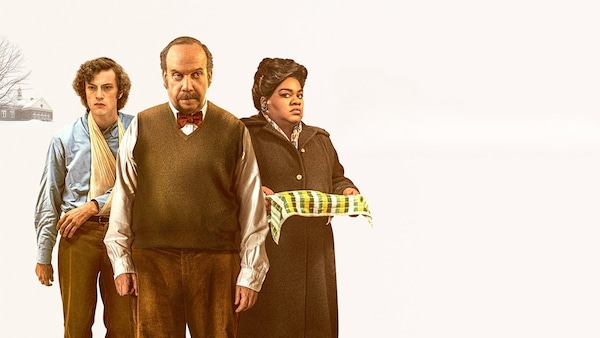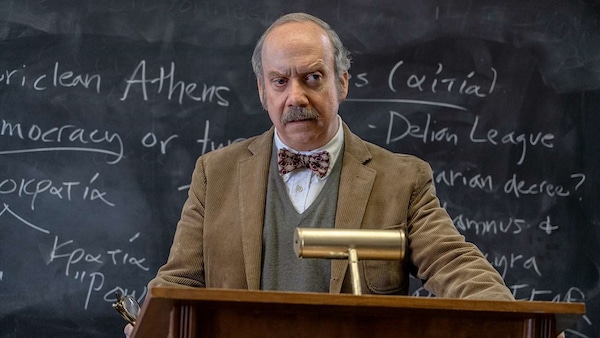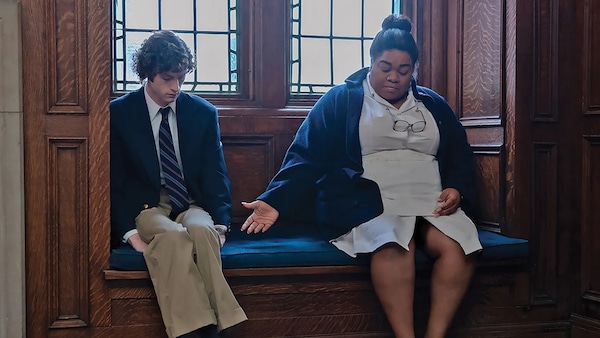The Holdovers Is A Moving Hymn To Loners, Malcontents & Found Families
Two decades after Sideways (2004), Paul Giamatti and Alexander Payne reunite for a movie which pulses with a warmth and tenderness at odds with its protagonist’s killjoy persona.

Last Updated: 01.19 AM, Feb 17, 2024
PAUL HUNHAM (Paul Giamatti) suffers from a condition that can perhaps only be described as Resting Grinch Face. Eternally crabby and generally unfriendly, Paul is disliked by students and faculty alike at Barton Academy, a prestigious New England boarding school where he teaches ancient history. Part of his infamy comes from the near-relish he seems to take in failing his students, rather than inspiring them. Rest assured, Paul won’t be getting the “O Captain! My Captain!” treatment from his students.
As punishment for failing the son of a senator, Paul is forced to babysit five students who have nowhere to go for the Christmas holidays. It stands to reason no student wants to be spending their break with a man who, well, curdles the eggnog and calls them things like “rancid little philistines,” “hormonal vulgarians,” “snarling Visigoths,” “entitled degenerates,” “fetid layabouts” and “genuine troglodytes”. Yes, Paul loves a good, well-timed, bruising insult with just enough sophistication to show off his subject of expertise and just enough cruel honesty to cut a student to the quick. His words broadcast a wit, sharpened and polished over years of gnarled experience and crabbed misanthropy. Needless to say, Paul doesn’t come from the school of thought that advocates: if you can’t say anything nice then don’t say anything at all.
And thank goodness for that!

Because Paul Giamatti’s tart delivery of said insults is one of the smaller but striking pleasures of The Holdovers, Alexander Payne’s moving hymn to loners, malcontents and found families. Two decades after Sideways (2004), Giamatti and Payne reunite for a Christmas movie, one which pulses with a warmth and tenderness at odds with its teacher-protagonist’s killjoy persona. Holiday season may mean a well-deserved pause at the end of the year for those celebrating with their families. But for those left behind, forgotten or grieving, it can be a painfully lonely time.
Stuck with Paul for the duration of the 1970-71 winter break are a couple of wounded souls: Angus Tully (Dominic Sessa), a sullen teen whose mother has ditched him for a last-minute honeymoon with her new husband, and Mary Lamb (Da’Vine Joy Randolph), the school cafeteria manager coping with the death of her son in the Vietnam War. The vastness of an empty school campus only compounds the alienation of a festive season from which they feel excluded. If all this sounds like a downer, The Holdovers matures into an oddly uplifting tale about discovering the spirit of holiday season outside the traditional family unit. Melancholy without being morose, sweet without being syrupy, the film allows for the possibility of the luminous grace that can be found in human connection.

Once a student at Barton himself, Paul has become such a stickler, students describe him as a Nazi-in-hiding and even the headmaster (Andrew Garman) urges him to “at least pretend to be a human being”. The headmaster himself was once Paul’s student. The frustration over not having lived up to potential and having failed as a writer manifests in Paul’s severity as a teacher. His insults, his drinking problem, his cynicism, are all coping mechanisms. It appears even his body has built its own — a fishy stink — to keep people at arm’s length. The strength of Giamatti’s performance lies in how his longing for connection still pierces through from his encrusted shield and a lazy eye.
Of the five students placed in Paul’s care, four are whisked away by helicopter on a ski trip. Angus is the only one left behind because his mother can’t be reached to grant permission. Feeling abandoned twice over, he hides his hurt behind sarcasm and expresses it via the odd act of rebellion. Angus and Paul trade plenty of jibes until finding companionship in their shared loneliness encourages them to drop their guards. For a young actor making his debut, Sessa has no trouble holding his own against the seasoned Giamatti, bringing empathy and a bit of chaos to a troubled teen.

But it is Randolph who emerges as the beating heart of the film. It is Mary who most gently sways Paul and Angus into dropping their guards, sometimes with a mere glance. Randolph communicates so much through stillness. At a party, listening to an Artie Shaw record, Mary tears up, her eyes revealing the pain of a mother looking back but also the strength it takes to not lose her spirit. For years, Mary has worked as a cook at Barton, serving privileged white boys and faculty members so that her son Curtis too could attend the same school and then go to college. To afford college, Curtis enlisted in the military, only to end up losing his life and his future with it in the Vietnam War. The racial and class disparities that exist in access to education aren’t spelled out, but are self-evident.
From the title design to the mono sound mix to the emphasis on browns in the colour scheme, The Holdovers embodies the essence of the 1970s and the spirit of the holidays in all its warmth. But its most old-timey but meaningful flourish is its use of dissolve. Like a time machine, the dissolve takes us forward and backwards in time. In a film where loneliness, pain and yearning seem to forever linger on the edge, it also creates the weightless effect of time healing all wounds.
The Holdovers, a Best Picture nominee at the 2024 Oscars, is out in theatres across India.
